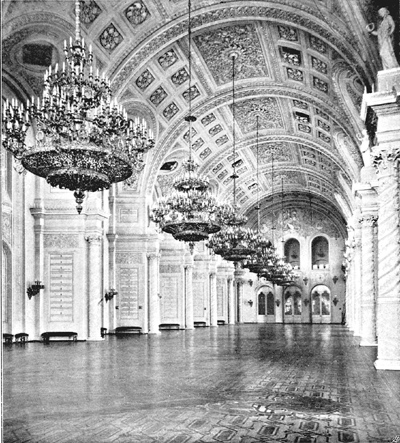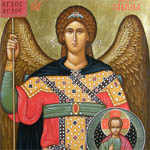Find a list of companies we've designed and developed innovative websites for at Pallasweb.com
Written, under the order of Prince Odoievsky-Maslov, Chief of Administration of the Imperial Court in Moscow, by S. de Bartenev
St. George Hall

This is the largest of all the halls of the Palace. According to the expression of Metropolitan Philaret, "The temple of St. George the Victorious is destined to be the Sanctuary of Glory for the victorious Russian Army."
The ornamentation of the hall corresponds to this destination. A collonade of 18 twisted columns, made of zinc, is used in front of the pillars which support the enormous vault. Under the capitals are placed figures of Victories on shields on which the arms of the provinces and kingdoms conquered by Russia with the date of each conquest. They are, beginning on the right:
- 1472 - The conquest of Perm
- 1489-99 - The conquest of Viatka
- 1553 - Conquest of the Kingdom of Kazan
- 1557 - Defeat of the Golden Horde
- 1582 - Conquest of Siberia
- 1639-43 - Conquest of Kamchatka
- 1654 - Annexation of Lesser Russia
- 1702 - Annexation of the banks of the Neva
- 1721 - Annexation of the Ingermanland and Karelia
- 1722-23 - Annexation of Derbent and Baku
- 1783 - Conquest of Tauride
- 1791 - Peace of Issay, Annexation of Lesser Tartary
- 1794 - Conquest of the Kingdom of Poland
- 1801 - Annexation of Georgia
- 1809 - Annexation of Finland and the Aland Islands
- 1812 - Annexation of part of Persia
- 1812 - Annexation of Bessarabia
- 1828 - Annexation of Armenia
The names of the regiments which took part in these conquests and those of the Knights of the Order of St. George are engraved on marble plaques which cover the walls and pillars. These names are also inscribed in the books, which are stored in the two bronze engraved coffers which are placed in front of the windows on the Moskova side.
Under the names of the regiments are engraved the cyphers of the Tsars under whose reign these regiments were created.
The vaults and murals of this hall are adorned with the insignia of the order of St. George. In the arch of the two walls at each end of the hall are releifs representing St. George on horseback and the dragon he has pierced with his lance.
Facing the central window, on the river side, we find under a glass case a group in silver, depicting Ermak, the cossack who conquered Siberia, and Count Platov. This work was given in 1870 by the Don Cossacks to their August Hetman, Tsarevich Alexander Alexandrovich, the future Alexander III, on the occassion of the three hundred year anniversary of the existance of the Don Cossack troops.
The mantlepieces, in carrera marble, next to the windows on the south, show sculpted trophies, the work of Campioni. On each mantle are gilt bronze clocks, also ornamented with trophies; on one a St. George, on the other Minin and Pojarsky.
The benches and stools with gilt feet are covered in silk, in the same color as the ribbon of the Order of St. George.
The magnificent parquet floor, appearing like an immense carpet, is made from more than 20 different species of precious woods, each a different color.
The Hall is lit by a double row of windows and at night by more than 3000 electric lamps, on six bronze chandeliers, with four arms and on the top of the entire cornice of the room.
The door which opens to the passage which attaches to the St.Vladimir Hall is made of stained glass. The design, in opaque glass reproduces the insignias of the Order.
On the east side of the St. George Hall is a covered gallery attached to the porticos of the Cathedral of the Annunciation.
On the days of the grand ceremonies, the civil authorities, the representatives of the Nobility of Moscow and those of the City will gather in this Hall.

